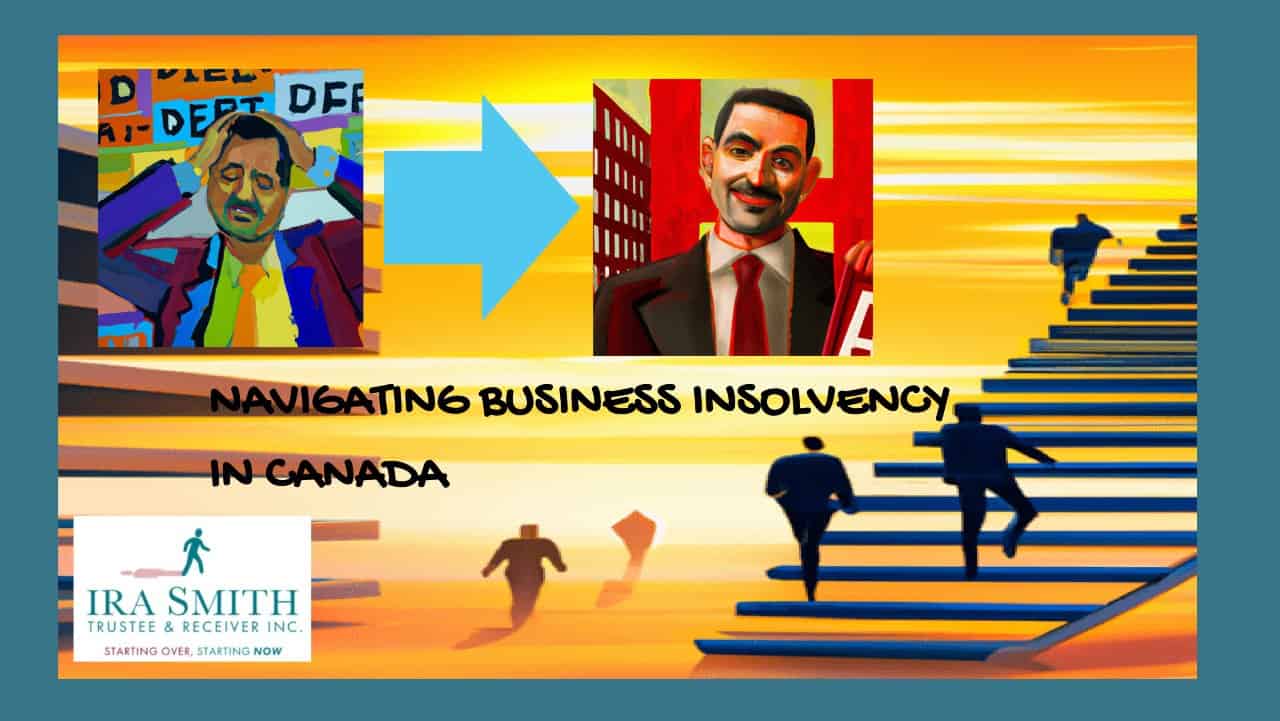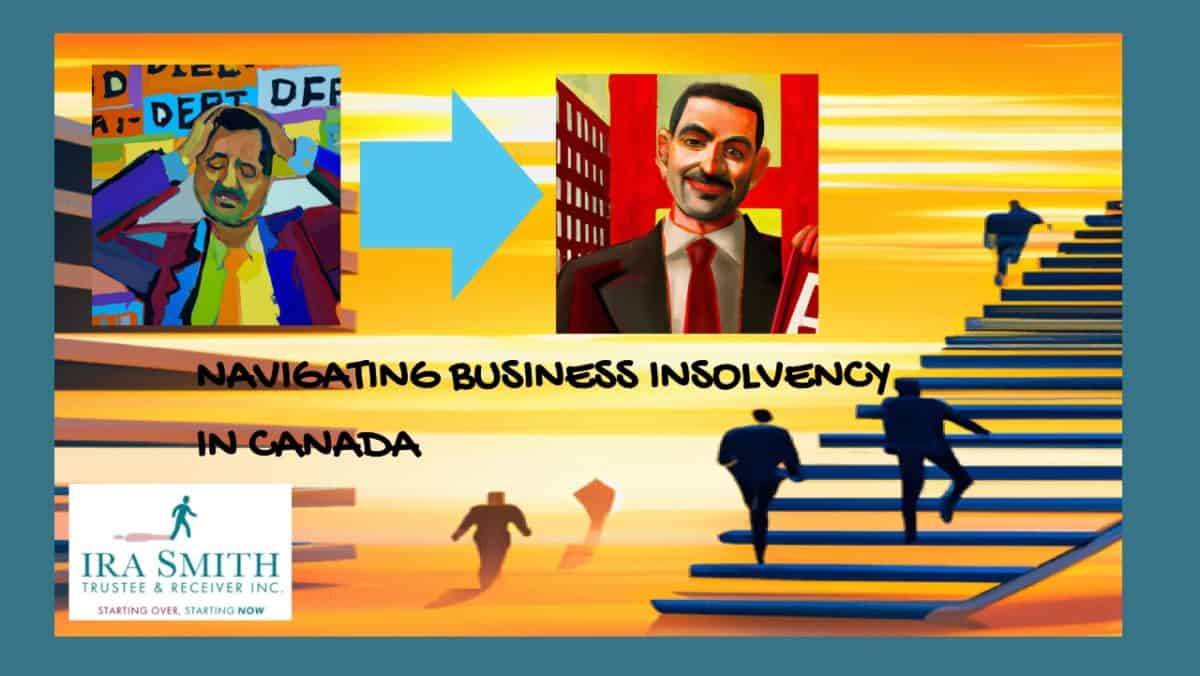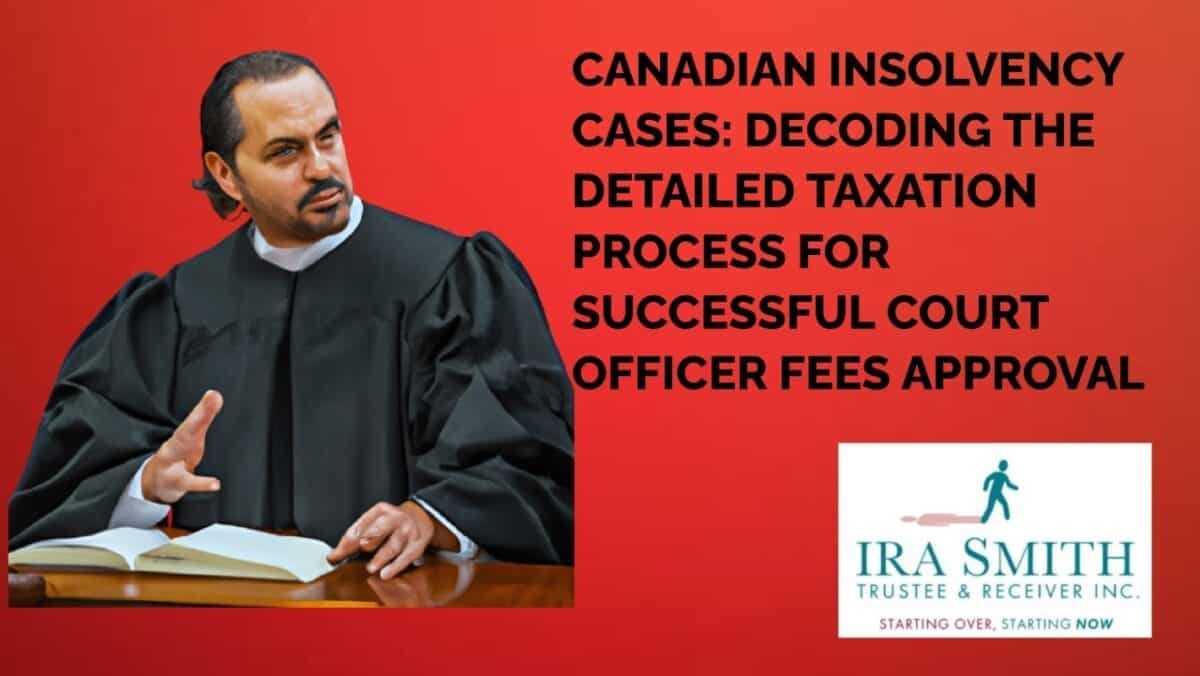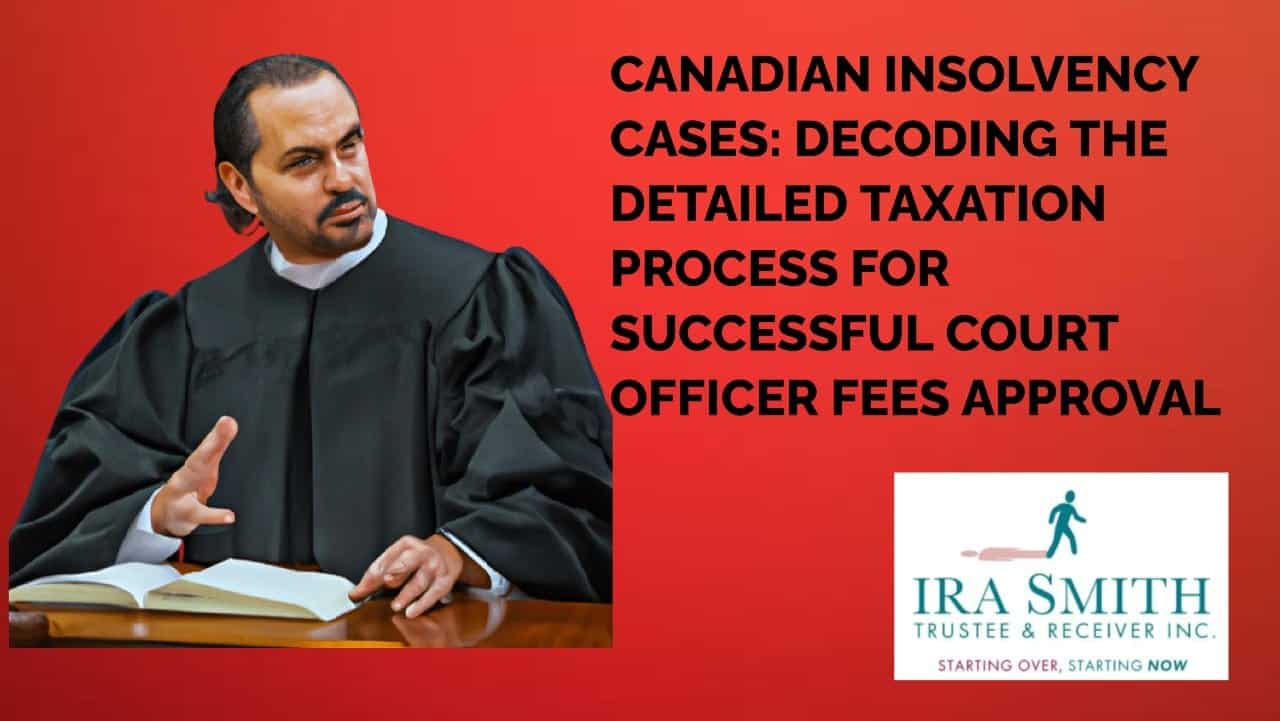Introduction to Business Insolvency
Welcome to our Brandon’s Blog where we will explore the intricate world of insolvency and its profound impact on businesses in Canada from my perspective as a professional in the field. In this exploration of business insolvency, we will uncover the implications that insolvency brings for creditors, shareholders, their lawyers and accountants, and employees alike.
Understanding the complexities of financial distress is crucial for businesses to navigate through turbulent times successfully. Join me as we discuss effective strategies and best practices to mitigate the challenges of insolvency, ensuring a smoother transition toward financial stability.
Definition of Business Insolvency
Business insolvency in the Canadian context refers to the financial state of a business where it is unable to pay its debts as they become due. It is a financial condition, not a legal one. Do not confuse the business or company with the financial condition of being an insolvent person with the legal condition of being involved in bankruptcy proceedings. Corporate insolvency is not corporate bankruptcy.
Corporate insolvency results in the business being unable to pay its debts when due which may make it impossible for the business to continue its operations. Insolvent companies may very well end up in the legal state of bankruptcy or as an alternative to bankruptcy, in insolvency restructuring proceedings.
Business insolvency can force the business to choose one of the insolvency options for businesses, including bankruptcy filings or proposals for restructuring and repayment plans under the Bankruptcy and Insolvency Act (Canada) (BIA).
In Canada, the number of business insolvencies has been on the decline for many years, but the impact of the COVID-19 pandemic has seen a reversal of this trend. Business insolvency filings are on the rise again. However, there are many small businesses where a business bankruptcy process does not make any sense as there are either no or few assets to offset the large company debts. We get calls daily from entrepreneurs of such companies where we tell them it is in their best interests to merely close the business doors rather than spend money to put their company into bankruptcy.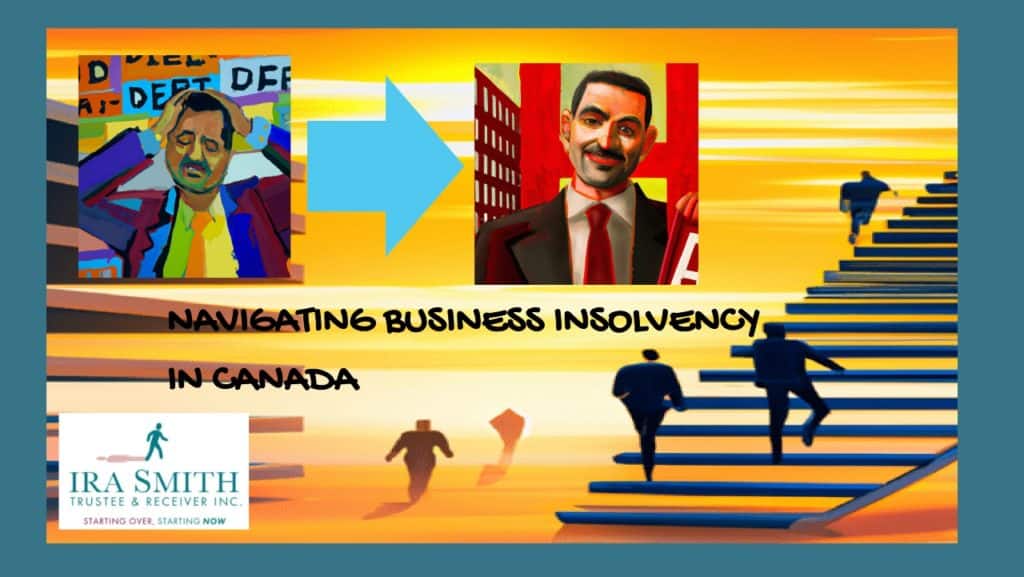
Causes and Warning Signs of Business Insolvency
Economic Downturn and Market Volatility
One of the primary contributors to business insolvency in Canada is the unpredictable nature of economic fluctuations and market volatility. As businesses strive to adapt to shifting market trends and consumer demands, they are often met with unforeseen challenges that can strain financial resources. Economic downturns, changes in consumer behaviour, and global market dynamics all play a pivotal role in determining the financial health of businesses across various sectors.
Cash Flow Problems: Overleveraging and Excessive Debt Burden
Another significant factor that can precipitate business insolvency is overleveraging and an excessive debt burden. While leveraging can be a strategic tool for growth and expansion, it becomes problematic when businesses accumulate debt beyond their capacity to repay. High levels of debt, coupled with declining revenues or profitability, can create a precarious financial situation, ultimately leading to insolvency if left unaddressed.
Poor Financial Planning and Management
Effective financial management and planning are essential components of sustainable business operations. However, inadequate financial oversight and poor planning can leave businesses vulnerable to insolvency. From misaligned budgeting strategies to ineffective cash flow management, deficiencies in financial management practices can exacerbate existing challenges and hasten the onset of insolvency.
Regulatory Compliance and Legal Challenges
Navigating the complex regulatory landscape in Canada can pose significant challenges for businesses, especially concerning compliance and legal matters. Failure to adhere to regulatory requirements, such as tax obligations or industry-specific regulations, can result in legal disputes, penalties, and fines, placing additional strain on financial resources. Moreover, litigation and legal challenges can further impede business operations and contribute to business insolvency.
Technological Disruption and Industry Shifts
The rapid pace of technological innovation and industry shifts can disrupt traditional business models and market dynamics, presenting both opportunities and challenges for businesses in Canada. Failure to embrace technological advancements or adapt to changing industry trends can render businesses obsolete or inefficient, leading to a decline in competitiveness and financial viability. As such, businesses must remain agile and proactive in leveraging technology to stay ahead of the curve and mitigate the risk of insolvency.
External Shocks and Unforeseen Events
External shocks and unforeseen events, such as natural disasters, geopolitical instability, or pandemics, can have profound implications for business continuity and financial stability. The unprecedented disruptions caused by such events can severely impact supply chains, disrupt operations, and erode consumer confidence, thereby jeopardizing the financial health of businesses. While certain external shocks may be beyond the control of businesses, proactive risk management and contingency planning are essential to mitigate their adverse effects.
Remember, proactive planning, decisive action, and collaboration with knowledgeable professionals are the cornerstones of navigating business insolvency effectively.
Business Insolvency: Overview of Insolvency Law in Canada
In Canada, insolvency law plays a vital role in guiding businesses through financially distressed situations. As a professional knowledgeable in this field, I will delve into the types of insolvency proceedings and the key legislation and regulations that govern insolvency processes.
- Types of Insolvency Proceedings: In Canada, businesses can navigate various types of insolvency proceedings:
- bankruptcy;
- proposal;
- corporate restructuring;
- receivership.
Bankruptcy involves the liquidation of assets to repay creditors, while a proposal allows for negotiating repayment plans to avoid bankruptcy. For larger corporations, corporate restructuring under different legislation than a proposal (discussed next) is available. Finally, when a secured creditor enforces its security to liquidate the business assets, that is receivership.
Understanding the nuances between these proceedings is essential for businesses facing financial challenges. All of these proceedings are described in detail in my previous blogs in the Lawyer and Accountant Series over the last few weeks.
- Key Legislation and Regulations: The BIA applies to all business bankruptcy, proposal and receivership proceedings in Canada. The Companies’ Creditors Arrangement Act (CCAA) applies to corporations that owe more than $5 million to creditors who wish to avail themselves of Canadian bankruptcy protection to restructure their operations and finances.
These are the pivotal legislation for an insolvent person, be they a consumer, individual, proprietorship, partnership or corporation. They govern personal insolvency and business insolvency in Canada. The BIA will govern any personal bankruptcy or corporate bankruptcy.
Understanding these aspects of insolvency law is imperative for businesses as they navigate through financial difficulties. By recognizing the procedures and regulations outlined in the key legislation, businesses can protect their interests and work towards a successful resolution of insolvency issues.
As we continue to unravel the intricate landscape of insolvency law in Canada, I will now explore the specific roles of lawyers and accountants in business insolvency, shedding light on their invaluable contributions to navigating insolvency proceedings effectively.
Role of a Lawyer in Business Insolvency
Lawyers play a critical role in guiding businesses through the challenging landscape of insolvency. There are many complexities and responsibilities involved in representing clients during financial distress. Let’s explore the legal responsibilities and duties, as well as effective strategies for representing clients in insolvency proceedings.
Legal Responsibilities and Duties
A lawyer’s primary responsibility is to ensure that their clients navigate the legal proceedings smoothly, legally and ethically. Upholding the highest standards of professionalism and compliance with relevant laws is paramount in protecting the interests of all involved parties. From providing sound legal advice to negotiating on behalf of clients, every action must align with the legal framework outlined in insolvency law.
In insolvency proceedings, it’s essential to draft and review legal documents meticulously, such as restructuring plans and agreements, to safeguard the rights of creditors, shareholders, and employees. Transparency and adherence to the law are non-negotiable aspects that guide a lawyer’s responsibilities in representing clients effectively.
Strategies for Representing Clients
When representing clients in business insolvency cases, adopting a strategic approach is key to achieving successful outcomes. Clear communication with clients to understand their objectives and concerns forms the foundation of developing a tailored strategy. By conducting in-depth research, analyzing financial documents, and collaborating with other professionals like accountants and insolvency practitioners, lawyers can offer comprehensive legal services.
Each client’s situation is unique, requiring a personalized strategy that addresses their specific needs and goals. Through a combination of legal expertise, practical considerations, and proactive communication, lawyers strive to navigate the complexities of insolvency proceedings effectively. By working collaboratively with clients and other professionals, especially the insolvency professionals, they can secure the best possible resolutions for their clients’ insolvency challenges.
Role of an Accountant in Business Insolvency
Accountants also play a critical role in the realm of business insolvency. The CPA understands the importance of financial analysis and compliance with accounting standards in navigating through the complexities of insolvency. Let’s explore how accountants play a pivotal role in helping businesses facing financial distress.
Financial Analysis and Reporting
Financial analysis and reporting are fundamental aspects of dealing with business insolvency. The accountant’s role involves carefully assessing the financial health of a company experiencing insolvency issues. By analyzing crucial financial statements, cash flow projections, and other relevant data, CPAs can provide insights that help the business understand its current financial situation.
Through their expertise in financial analysis, CPAs identify key areas of concern and create accurate reports that are essential for stakeholders, including creditors, shareholders, and employees, to make informed decisions. Effective financial analysis enables businesses to develop strategies for managing financial distress, paving the way for a smoother resolution of insolvency issues.
Compliance with Accounting Standards
Compliance with accounting standards is a cornerstone for businesses navigating insolvency in Canada. The CPA will ensure that the financial statements are prepared in adherence to the relevant accounting principles and regulations. This commitment to compliance promotes transparency and upholds the integrity of financial reporting.
By maintaining strict compliance with accounting standards, businesses demonstrate their dedication to ethical practices and financial accuracy. This, in turn, fosters trust among creditors, shareholders, and other stakeholders during times of financial distress. Upholding accounting standards is crucial for businesses to mitigate legal and financial risks, emphasizing the need for meticulous attention to regulatory requirements.
CPAs recognize the significance of financial analysis and compliance with accounting standards in guiding businesses through the insolvency process. By providing invaluable financial expertise ensuring adherence to regulatory guidelines, and working with other professionals, especially the insolvency professionals, the external CPA supports businesses in making well-informed decisions and navigating the complexities of business insolvency successfully.
This is how both non-insolvency lawyers and accountants can still play a meaningful role in business insolvency, especially in a business restructuring process. A successful outcome of the business restructuring is the best way for the existing lawyer and accountant to maintain both the client but also a close meaningful business relationship for the long term.
Impact of Business Insolvency
Job Losses and Unemployment
The impact of Canadian business insolvency on job losses and unemployment can be significant. When a business becomes insolvent, it may be forced to lay off employees or shut down entirely, leading to job losses. This can result in a higher unemployment rate as workers find themselves without a job and struggle to secure new employment.
The COVID-19 pandemic has exacerbated these challenges, with many entrepreneurial businesses in Canada continuing to face financial difficulties and the continued risk of closure. Such businesses are still struggling to return to normal revenues, carry unpaid debt taken on during the pandemic, and face rising costs and a shortage of labour.
Targeted measures and support for small businesses are crucial to prevent closures and job losses. By assisting, such as financial aid, access to resources, and support for restructuring, the impact of business insolvency on job losses and unemployment can be mitigated. Additionally, policies like the recent amendments to prioritize creditor claims related to defined-benefit pension plans can help protect employees’ financial security in the event of insolvency.
Effects on Suppliers and Creditors
The effects of Canadian business insolvency on suppliers and creditors can be significant. When a business becomes insolvent, suppliers may face challenges in receiving payment for goods or services provided to the business. This can result in financial difficulties for the suppliers themselves, especially if they rely heavily on the insolvent business as a major customer.
Creditors, including financial institutions and other lenders, may also experience losses when a business files for bankruptcy or proposes a restructuring plan. In most cases, creditors will not receive the full amount owed to them, or they may have to wait a significant amount of time to receive any repayment.
Overall, Canadian business insolvency can have a ripple effect on suppliers and creditors, leading to financial challenges and losses for those involved in the business’s operations. Suppliers and creditors need to assess their credit risks before extending credit and take appropriate measures to protect their interests in the event of a business insolvency.
Potential Closure or Sale of the Business
In Canadian business insolvency, the potential closure or sale of the business can have significant implications for the business owner, employees, creditors, and the economy as a whole. If an entrepreneurial business is unable to meet its financial obligations and is forced to close its doors, it can result in job losses, financial losses for creditors, and a decrease in economic activity in the local community.
For the business owner, the closure or sale of the business can mean the end of their entrepreneurial venture, financial loss, and potential personal liability for both Director liabilities as well as any corporate debt personally guaranteed by the entrepreneur. Such liabilities can have a significant impact on their financial well-being and prospects.
For employees, the closure of a business can result in job loss, uncertainty, and financial hardship. They may struggle to find new employment, especially if the closure is due to broader economic challenges in the industry or region.
For creditors, the closure of a business can mean they probably will not recover the full amount owed to them. They may have to write off the debt as a loss, which can impact their financial stability and ability to extend credit to other businesses.
In terms of the economy, the closure or sale of a business can contribute to a decrease in economic activity, reduced consumer confidence, and a negative impact on the overall business environment. It can also lead to a loss of tax revenue for the government, further impacting public services and infrastructure.
Overall, the potential closure or sale of a business in a Canadian business insolvency is a complex and challenging situation that requires careful consideration of the implications for all stakeholders involved. It underscores the importance of effective financial management, planning, and risk mitigation strategies for entrepreneurial businesses to avoid insolvency and closure in the first place.
Reputation Damage
Reputation damage arising from a Canadian business insolvency can have long-lasting effects on a company. When a business becomes insolvent, it is unable to fulfill its financial obligations, leading to creditors and suppliers losing trust in the company. This can result in difficulty in securing credit, partnerships, and contracts in the future.
Moreover, news of a business insolvency can spread quickly, damaging the company’s reputation among customers and stakeholders. Customers may lose faith in the company’s ability to deliver products or services, leading to a loss of business and revenue. Employees may also become concerned about job security and employee wages. Morale suffers and the most qualified employees can find new jobs quickly. All of this leads to morale suffering which makes the business insolvency closer to a self-fulfilling prophecy.
Reputation damage from a business insolvency can be difficult to overcome. Rebuilding trust with creditors, suppliers, customers, and employees may take time and effort. Companies trying to implement a restructuring insolvency plan need to implement strong communication strategies to address concerns and demonstrate a commitment to financial stability and responsibility.
Overall, reputation damage arising from Canadian business insolvency can have significant consequences for a company’s long-term success and viability. Businesses need to address insolvency issues promptly and transparently to mitigate potential reputational harm.
Navigating Business Insolvency Proceedings
Initiating the Insolvency Process
In Canada, the process of initiating insolvency proceedings is a critical step for businesses facing financial distress. There are two kinds of processes; 1. voluntary and 2. involuntary.
The voluntary process normally begins with the insolvent business formally declaring insolvency by filing for bankruptcy protection under either the BIA or CCAA to begin the restructuring process. Alternatively, the insolvent business can file corporate bankruptcy if liquidation is the only answer for a business that is no longer viable.
The involuntary process would normally begin with either a secured creditor privately appointing or making an application to the Court for the appointment of a receiver. Alternatively, one or more unsecured creditors owed in total at least $1,000 can launch a Bankruptcy Application against the insolvent company.
Seeking professional guidance from experts like insolvency lawyers and licensed insolvency trustees is essential to navigate this complex process effectively. Businesses can begin addressing their financial challenges by initiating insolvency proceedings and working toward a resolution.
Managing Stakeholder Relationships
Managing stakeholder relationships is paramount during times of business insolvency in Canada. Creditors, shareholders, and employees all have vested interests in the outcome of insolvency proceedings. Effective communication and transparency are essential to build trust and mitigate potential conflicts. By keeping stakeholders informed, addressing their concerns, and involving them in decision-making processes, businesses can navigate insolvency proceedings with clarity and confidence.
Business insolvency is a complex issue that requires careful navigation. By understanding the implications for all stakeholders and seeking professional advice, businesses can better prepare for financial challenges.
Resolving Legal issues Within a Business Insolvency
There are two main avenues for addressing legal issues within insolvency cases: 1. Negotiation and Mediation Techniques, as well as 2. Litigation and Court Proceedings. I will now delve into the strategies and approaches essential for navigating through challenging financial times successfully.
Negotiation and Mediation Techniques
When faced with legal issues within insolvency cases, negotiation and mediation techniques can be powerful tools for finding amicable solutions. Insolvency trustees find that engaging in constructive dialogue with stakeholders can often lead to mutually beneficial outcomes. By exploring innovative and collaborative approaches, businesses can avoid unnecessary conflicts and costly legal battles.
- Effective negotiation involves understanding the concerns and needs of all parties involved.
- Mediation offers a platform for open communication, ensuring that diverse perspectives are heard and respected.
- Skilled mediators facilitate the process, guiding toward agreements that protect the interests of creditors, shareholders, and employees.
By adopting a strategic and empathetic approach to negotiation and mediation, businesses can navigate the complexities of insolvency issues with resilience and integrity. The ability to find common ground and explore creative solutions is essential in any business restructuring.
Litigation and Court Proceedings
While negotiation and mediation are preferred methods for resolving legal issues within the insolvency case, there are instances where litigation and court proceedings become inevitable. This is more so within a liquidating bankruptcy proceedings rather than in a business reorganization. Licensed insolvency trustees understand the importance of legal recourse in protecting the rights and interests of all stakeholders involved.
- Litigation provides a formal platform for resolving disputes and making legally binding decisions.
- Court proceedings ensure that insolvency matters are adjudicated fairly and by the law.
- Legal experts specializing in insolvency law offer invaluable guidance throughout the litigation process.
By preparing meticulously and engaging competent legal representation, businesses can navigate the complexities of court proceedings with confidence. While litigation may signify a more adversarial approach, it can also lead to definitive resolutions that provide clarity and direction in times of financial turmoil.
4 Common Business Insolvency FAQs
- What is the difference between company insolvency and personal bankruptcy?
Company insolvency refers to a company that is unable to pay its bills and debts owed, while personal bankruptcy is a legal process for individuals who cannot pay their bills to eliminate debt.
- When should a company consider filing for bankruptcy?
A company should consider filing for bankruptcy or bankruptcy protection to restructure when they are facing overwhelming financial difficulties, such as a loss of income, high levels of debt, inadequate cash flow, and reliance on personal credit to meet obligations. This only makes sense if action is taken relatively early in the insolvency when there are still assets that can be used in perhaps a different corporate form to continue to run the viable part of the insolvent business.
- How much debt does a business need to owe to file for bankruptcy in Canada?
In Canada, an insolvent person or insolvent business needs to owe $1,000 or more to unsecured creditors to be eligible to file for bankruptcy.
- Can sole proprietorships and partnerships file for business bankruptcy?
Yes, sole proprietorships and partnerships can file for business bankruptcy, and they would need to work with a Licensed Insolvency Trustee to do so. In these forms of business, it is the sole proprietor or partners who would be filing bankruptcy. As this would be a consumer insolvency, the bankruptcy rules dealing with the insolvency of individuals would guide this kind of bankruptcy process.
Business Insolvency Conclusion
Navigating business insolvency in Canada is a multifaceted challenge that requires careful consideration and strategic planning. As a licensed insolvency trustee, I have explored the intricacies of insolvency law and its impact on businesses, creditors, shareholders, and employees. Understanding the complexities of insolvency is pivotal for businesses to weather financial storms successfully for a brighter financial future.
The role of corporate lawyers and accountants in helping to guide businesses through insolvency proceedings is an important one. By recognizing the significance of legal responsibilities, financial analysis, and compliance with accounting standards, businesses, with the help of a Licensed Insolvency Trustee and insolvency legal counsel can tackle insolvency issues with confidence and resilience.
I hope you enjoyed this business insolvency Brandon’s Blog. Individuals and business owners must take proactive measures to address financial difficulties, consumer debt and company debt and promptly seek assistance when necessary. It is crucial to recognize that financial stress is a prevalent concern and seeking help is a demonstration of fortitude, rather than vulnerability. Should you encounter challenges in managing your finances and find yourself burdened by stress, do not delay in pursuing aid.
Revenue and cash flow shortages are critical issues facing people, entrepreneurs and their companies and businesses with debt problems that are in financial distress. Are you now worried about just how you or your business are going to survive? Are you worried about what your fiduciary obligations are and not sure if the decisions you are about to make are the correct ones to avoid personal liability? Those concerns and more associated with your company debt are obviously on your mind.
The Ira Smith Team understands these overwhelming debt financial health concerns. More significantly, we know the requirements of the business owner or the individual who has way too much financial debt. You are trying to manage these difficult financial problems and you are understandably anxious. It is not your fault you can’t fix this problem on your own and it does not mean that you are a bad person. The pandemic has thrown everyone a curveball. We have not been trained to deal with this. You have only been taught the old ways. The old ways do not work anymore.
The Ira Smith Team uses innovative and cutting-edge methodologies, to adeptly navigate you through the intricacies of your financial challenges ensuring a resolution to your debt-related predicaments without resorting to the rigours of the bankruptcy process. We can get you debt relief now! We have helped many entrepreneurs and their insolvent companies who thought that consulting with a Trustee and receiver meant their company would go bankrupt.
On the contrary. We helped turn their companies around through financial restructuring. We look at your whole circumstance and design a strategy that is as distinct as you are. We take the load off of your shoulders as part of the debt settlement strategy we will draft just for you.
The Ira Smith Trustee & Receiver Inc. team understands that people facing money problems require a lifeline. That is why we can establish a restructuring procedure for you and end the discomfort you feel. Call us now for a no-cost consultation. We will listen to the unique issues facing you and provide you with practical and actionable ideas you can implement right away to end the pain points in your life, to begin your debt-free life, Starting Over, Starting Now.